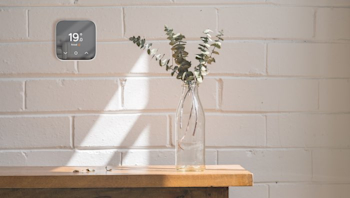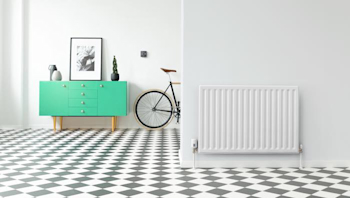Hive Radiator Valves explained: everything you need to know
If you’re considering buying (or have just bought) smart radiator valves for your home, chances are you’ll have questions about how they work.
Hive Radiator Valves are one of our most popular products. We’re always getting asked about the humble smart radiator valve, from how they can help you save money on heating to how to install them like a pro. Here’s everything you need to know about this handy little heating device and how it can transform your home.
What is a smart radiator valve and how do they work?
Let’s start with the basics. Just like traditional thermostatic radiator valves (TRVs), smart radiator valves determine how warm a room is by controlling the flow of hot water into an individual radiator.
They’re smart because unlike regular TRVs, these valves have their own temperature setting that you can adjust remotely from an app on your smartphone, tablet or smart watch. You can choose the exact temperature you want each room to be, whether you’re at home or out and about.
Do thermostatic radiator valves save money?
Smart radiator valves save money by giving you precise control of every radiator in your home, from wherever you are. You can select the temperature, set heating schedules or even turn radiators off all together, even when you’re not in the house.
Because you only need to heat rooms you’re actually using, over time you’ll see a difference in your energy bill as you won’t be wasting money heating empty rooms. For example, if you’re working from home, you could set a schedule that turns the heating on from 9am – 5pm in the room you work in, turning it off everywhere else.
How many Hive radiator valves do I need?
It’s entirely up to you. If you want full room by room control around your house then you’ll need a Hive Radiator Valve on your radiators in each room. But equally, to turn down the heating in one room while you’re not using it (think a spare room or bedroom), you just need a Hive Radiator Valve on that one radiator.
As you install more, you should start to see a significant reduction on your heating bills as it’s easier to keep the heat off in the rooms you don’t use that often.
What is Hive Heat on Demand? How can it help you use multiple TRVs?
Hive Heat On Demand (HOD) is a feature for people who have multiple Hive Radiator Valves and a Hive Thermostat. It essentially links these two devices, letting them communicate to turn your heating on when you want to warm a particular room up – without having to keep your heating on permanently.
If you have a Hive Thermostat, you can enable Heat On Demand in your Hive app. Once HOD is set up, your Hive Radiator Valve will boost your thermostat automatically to turn on your heating and warm up your radiators when they need it.
(If you don’t have a Hive thermostat, or if you disable Heat On Demand, turning up a Hive Radiator Valve will only warm up the room if your heating is already on.)
Getting the most out of Hive Heat on Demand
The way Heat On Demand works is that your Hive Radiator Valve will sense you need more heat and turn on your heating system to deliver it.
Heat on Demand works really well when you have Hive Radiator Valves on all your radiators. That way you can set which of your radiators you heat once your heating system is on and get complete room-by-room control.
The one watch-out is that Heat on Demand isn’t really designed for a situation where you have one Hive Radiator Valve and then lots of manual radiator valves. That’s because, when your HRV triggers your heating system, you may end up warming more of your house than you intended.
Do Hive Radiator Valves work with multi zone heating?
Yes, Hive Radiator Valves work fine with multi zone heating installations, where each zone is controlled by a separate thermostat.
If you have Hive Multizone heating already, you can actually link each Hive Radiator Valve to a specific thermostat. Then Heat On Demand will only boost the heating in the zone linked to the Hive Radiator Valve that needs heat – for example, your ‘upstairs’ thermostat, if it’s a bedroom radiator that you want to warm up.
Hive radiator valve installation 101: Everything you need to know
How to fit thermostatic radiator valves
These days, as most radiators have TRVs fitted already, fitting Hive Radiator Valves is pretty straightforward. Check yours – if the valve on your radiator has a numeric dial (e.g. showing numbers 1-5), it’s a TRV.
To install, you simply unscrew the existing TRV and replace it with a Hive Radiator Valve. There’s no need to drain your radiator, as long as you already have a compatible valve attached. You might need to use an adaptor (which comes included) but we’ll show you exactly what to do – simply follow the step-by-step instructions in the Hive app or check out our Hive Radiator Valve installation guide.
Some top tips for Hive radiator valve installation
When considering where to fit thermostatic radiator valves, remember:
Don't install TRVs in the same room as your thermostat
We recommend that you don’t fit Hive Radiator Valves to any radiators in the same room as any main thermostat. If the thermostat is set to a higher temperature than the valve, having both in the same room can cause your heating to be permanently on.
Don't obscure TRVs with furniture or anything else
Hive Radiator Valves are clever little devices that use a complex algorithm to measure the temperature in the middle of the room. To work at their best, air must be able to flow freely around the valve – so it’s important to make sure no furniture is pressed up against them. If obscured, they can read higher or lower than the temperature in the middle of the room.
Post-installation: Hive radiator valve calibration explained
Now that you’ve successfully installed your Hive Radiator Valves (hooray!) it’s time to let them calibrate.
Calibration is a learning phase, during which the valve determines the optimum opening point (when hot water starts to flow) of the valve body. It does this so that it can manage room temperature consistently, making the battery last as long as possible.
What happens if I don’t calibrate my system?
Without calibration, the valve will open very slowly in order to detect the correct opening point accurately. This means it can take up to two hours for your radiator to warm up.
During this time, both the app and Hive Radiator Valve will show the temperature you have selected, but the radiator may stay cold while the valve slowly opens. This is likely to happen until the valve is calibrated.
A few points on Hive TRV calibration:
Your heating needs to be on during calibration. If you install your Hive Radiator Valve over the summer and your heating is off, it will start calibrating the next time you turn it on.
You can still use your Hive Radiator Valves even if they aren’t calibrated, it will just take a little longer for your radiator to warm up (30-60 mins rather than 5-15 mins)
To test that your Hive Radiator Valve is working while it calibrates, use the dial on the front to set it to a high temperature. The valve should open immediately.
How long should it take for my radiators to heat up normally?
We get asked this one a lot. Even when your Hive Radiator Valve is fully calibrated, it can take 5-15 minutes to fully open after getting a command from the app. This helps save battery life and avoids any temperature overshoots - so you stay comfortable and don’t waste money on excess energy. Don’t forget: radiators will only warm up if the heating is on!
You can find a more detailed guide on Hive Radiator Valve calibration here.
Smarten up your system with Hive Radiator Valves
Got a question about Hive Radiator Valves, installation or calibration that hasn’t been answered here? Search for it on our Hive Community page or get in touch using our Help page.







